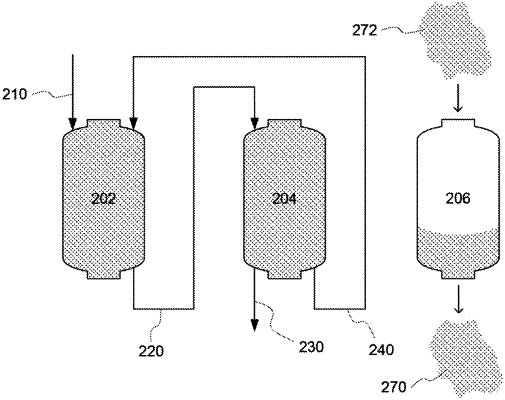| CPC C10G 1/002 (2013.01) [C10G 1/02 (2013.01); C10G 1/045 (2013.01); C10G 2300/4006 (2013.01); C10G 2300/4031 (2013.01)] | 38 Claims |

|
1. A method of recovering hydrocarbon products from oil shale, comprising:
injecting a working fluid into a first vessel in a pyrolysis mode, wherein the working fluid consists of one or more of a combustion product gas, a non-condensable hydrocarbon product from pyrolysis, methane, and natural gas, wherein the first vessel contains particulate oil shale, wherein the working fluid has a temperature at or above a production temperature, wherein the production temperature is sufficient to pyrolyze kerogen in the oil shale, wherein the particulate oil shale in the first vessel has an average temperature at or above the production temperature and is a substantially stationary bed during heating;
concurrently flowing an effluent out of the first vessel, said effluent including the working fluid, condensed hydrocarbon product, condensable hydrocarbon product, and non-condensable hydrocarbon product and optionally removing condensed hydrocarbon product, and injecting the effluent into a second vessel in a preheating mode, wherein the second vessel contains particulate oil shale having an average temperature below the production temperature so as to capture heat from the effluent sufficient to increase the average temperature of the particulate oil shale and to condense at least a portion of the condensable hydrocarbon product to increase a volume of the condensed hydrocarbon product and to avoid rejecting heat to surrounding environment through external heat exchangers, and wherein the second vessel is a substantially stationary bed during heating and mineral fines entrained in the effluent are at least partially removed from the effluent via filtering and adsorption to the particulate oil shale and entrained mists of condensed hydrocarbons are consolidated with the condensed hydrocarbon product as a liquid;
concurrently collecting liquid hydrocarbons from the second vessel, said liquid hydrocarbons including the condensed hydrocarbon product; and
concurrently flowing a second effluent out of the second vessel, said second effluent including the working fluid and non-condensed hydrocarbon product, and recycling the second effluent to the first vessel.
|